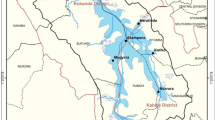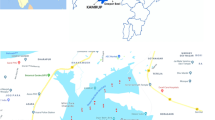Abstract
Loktak Lake is the largest natural freshwater lake of Northeastern India, characteristic by floating islands, known as Phumdis. The lake supports rich biodiversity including some globally threatened species, hence declared as a Ramsar Site. The lake facilitates hydropower, irrigation and provides a livelihood to the local villagers in the form of fishing and agriculture. Loktak Lake is deteriorating in recent years due to rapid urbanization, increased settlement and other anthropogenic activities. A study was, therefore, undertaken to assess the water quality and its trends for this important lake. The water quality of Loktak Lake was assessed in monthly intervals for a period of 3 years, using multiple water quality indices. Temporal distribution functions of the individual water quality parameters and indices were developed to assess the water quality trend of the lake. Overall water quality of this lake was found to be good throughout the year with slight deterioration during winter. However, the water of this lake was a little turbid and contained significant organic load.

















Similar content being viewed by others
References
American Public Health Association and American Water Works Association (1999) Standard methods for the examination of water and wastewater, 20th edn. American Public Health Association (APHA), Washington, DC
Brown RM, McClelland NI, Deininger RA, Tozer RG (1970) A water quality index - do we dare? Water Sew Works 117(10):339–343
Bureau of Indian Standards (2012) Indian standard drinking water specification (second revision)
Canadian Council of Ministers of the Environment (2001) Canadian environmental quality guidelines for the protection of aquatic life. CCME water quality index: technical report, 1.0
Devi NB, Sharma BM (2002) Life form analysis of the macrophytes of the Loktak Lake, Manipur, India. Indian J Environ Ecoplan 6(3):451–458
Gupta S (2012) Lake Loktak in Manipur North East India: major issues in conservation and management of a Ramsar Site. Bionano Front 9:6–10
Kangabam RD, Bhoominathan SD, Kanagaraj S, Govindaraju M (2017) Development of a water quality index (WQI) for the Loktak Lake in India. Appl Water Sci 7(6):2907–2918
Kosygin L, Dhamendra H (2009) Ecology and conservation of Loktak Lake, Manipur: an overview. In: Wetlands of North East India: ecology, aquatic bioresources and conservation. Akansha Publishing House, New Delhi, pp 1–20
Laishram J, Dey M (2014) Water quality status of Loktak Lake, Manipur, Northeast India and need for conservation measures: a study on five selected villages. Int J Sci Res Publ 4(6):1–6
Loktak Development Authority (LDA) (2002) Phumdis management, Loktak newsletter, vol 2. Loktak Development Authority, Imphal and Wetland International-South Asia, New Delhi
Moharana C, Chinmoy P, Nitin K (2014) Potable water is a serious environmental issue: a special study on Umiam area, of RI-Bhoi District, Meghalaya, India. Int Res J Environ Sci 3:37–42
National Wetland Atlas: Wetlands of International Importance under Ramsar Convention (2013) Space Applications Centre, ISRO, Ahmedabad, Loktak Lake, pp 117–123
Rai SC, Raleng A (2011) Ecological studies of wetland ecosystem in Manipur valley from management perspectives. In: Ecosystems biodiversity. InTechOpen
Roy R, Majumder M (2017) Comparison of surface water quality to land use: a case study from Tripura, India. Desal Water Treat 85:147–153
Sharma ASC, Gupta S, Singh NR (2013) Studies on the physio-chemical parameters in water of Keibul Lamjao National Park, Manipur, India. J Environ Biol 34:1019–1025
Singh AL, Khundrakpam ML (2011) Phumdi proliferation: a case study of Loktak Lake, Manipur. Water Environ J 25(1):99–105
Singh CR, Thompson JR, French JR, Kingston DG, Mackay AW (2010) Modelling the impact of prescribed global warming on runoff from headwater catchments of the Irrawaddy River and their implications for the water level regime of Loktak Lake, northeast India. Hydrol Earth Syst Sci 14:1745–1765
Suresh VR (2000) Floating islands: a unique fish aggregating method. Naga ICLARM Q 23(1):11–13
Takhelmayum K, Gupta S (2011) Distribution of aquatic insects in phumdis (floating island) of Loktak Lake, Manipur, North-eastern India. J Threat Taxa 3(6):1856–1861
World Health Organization (2017) Guidelines for drinking-water quality, 4th edn. World Health Organization, Geneva
Author information
Authors and Affiliations
Corresponding author
Additional information
Publisher's Note
Springer Nature remains neutral with regard to jurisdictional claims in published maps and institutional affiliations.
Rights and permissions
About this article
Cite this article
Roy, R., Majumder, M. Assessment of water quality trends in Loktak Lake, Manipur, India. Environ Earth Sci 78, 383 (2019). https://doi.org/10.1007/s12665-019-8383-0
Received:
Accepted:
Published:
DOI: https://doi.org/10.1007/s12665-019-8383-0




